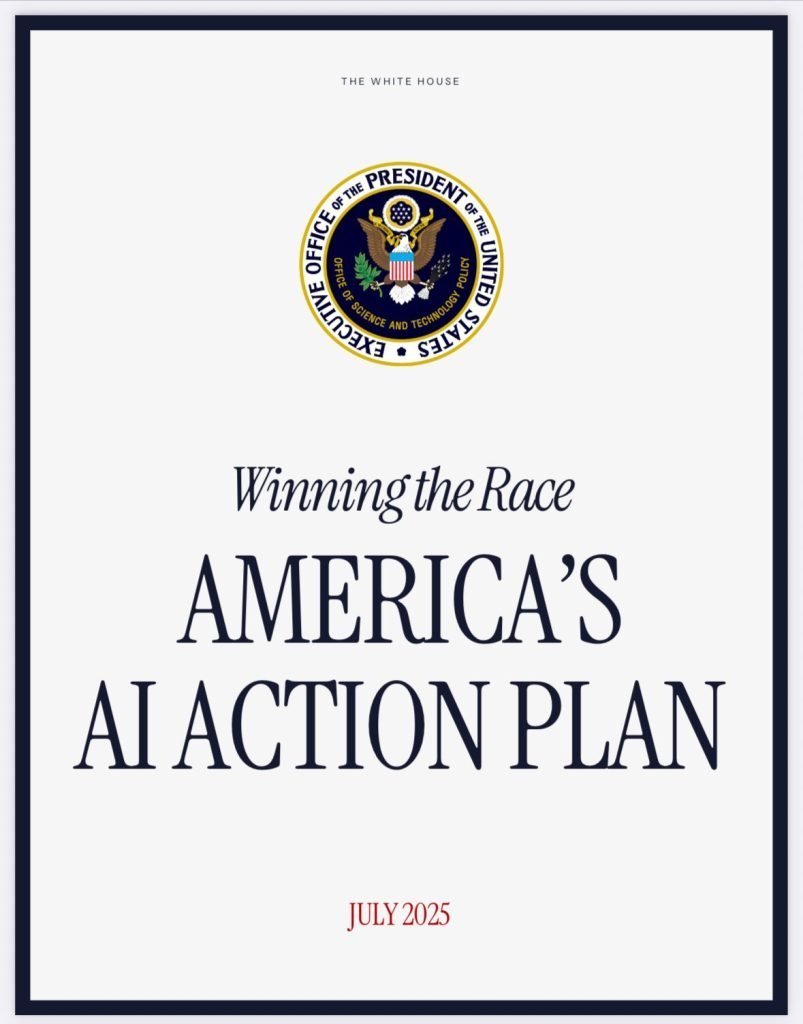Tools & Platforms
Trump’s tech supremacy strategy decoded

- Trump’s AI Action Plan eliminates regulations, boosts infrastructure to create US “unchallenged” tech monopoly.
- Three-pillar strategy to assert AI dominance, blocking competitors’ access to technologies.
It has become increasingly apparent, especially in the US, that the era of polite technological competition is officially over. President Donald Trump’s “Winning the AI Race: America’s AI Action Plan,” unveiled on July 23, 2025, represents nothing less than a formal declaration of digital warfare – a comprehensive battle strategy designed to obliterate competitors and establish permanent American hegemony in what’s regarded by many as the most consequential technology of our time.
From an editorial point of view, this isn’t diplomacy; it’s technological imperialism wrapped in a policy framework, and every line of code, every silicon wafer, and every data centre becomes a weapon in the conflict.
The strategic message: America first, America only
Trump’s foreword to the action plan crystallises the administration’s worldview with startling clarity: America must “achieve and maintain unquestioned and unchallenged global technological dominance” as a fundamental pillar of national security.
This isn’t diplomatic language softened for international consumption – it’s a bold proclamation that the US views AI supremacy as non-negotiable. The messaging strategy embedded in the 28-page document reveals Washington’s intent to frame the global AI landscape not as a collaborative ecosystem, but as a zero-sum competition where American victory requires competitor defeat.
As White House Office of Science and Technology Policy Director Michael Kratsios declared, this plan “galvanises Federal efforts to turbocharge our innovation capacity, build cutting-edge infrastructure, and lead globally, ensuring that American workers and families thrive in the AI era.”
Pillar one: Freeing American innovation through regulatory demolition
The first strategic pillar sends a clear message to domestic and international audiences: America will win by removing constraints that other nations maintain. The plan’s aggressive deregulatory approach positions the US as the world’s most business-friendly environment for AI development, explicitly targeting what it calls the “onerous Federal regulations” of previous administrations.
Vice President JD Vance’s rhetoric reinforces the narrative, warning against “paralysing one of the most promising technologies we have seen in generations.” The subtext is unmistakable – while other nations burden their AI sectors with restrictive regulations, the US free its innovators from the burden of legislative oversight.
The plan goes further by threatening to withhold federal funding from states that enact “burdensome AI regulations,” effectively federalising the deregulatory approach and ensuring that no local jurisdiction can undermine national strategy, centralising control while projecting an image of unified American purpose.
Perhaps most significantly, the plan mandates that AI systems funded by taxpayers must reflect “American values” – defined as systems that are “objective and free from top-down ideological bias.”
The cultural positioning attempts to frame American AI as inherently superior, not just technologically, but morally, while simultaneously removing concepts like misinformation monitoring and Diversity, Equity, and Inclusion from official AI risk frameworks.
Pillar two: Building the arsenal of the AI age
The second pillar reveals Washington’s understanding that AI supremacy requires more than software – it demands a complete industrial transformation. The plan’s “Build, Baby, Build!” philosophy represents nothing less than a new Manhattan Project for the digital age.
“AI is the first digital service in modern life that challenges America to build vastly greater energy generation than we have today,” the plan states with characteristic bluntness. The acknowledgement posits that the US is the only nation capable of meeting AI’s massive infrastructure demands, and signals to competitors that America will spare no expense to build this foundation.
The strategy encompasses rapid data centre construction, semiconductor manufacturing reshoring, and power grid modernisation – including ambitious bets on nuclear fusion. By fast-tracking environmental permits and overhauling regulatory frameworks, the administration signals that constraint will not limit American ambitions.
The CHIPS Programme Office receives particular attention, with promises to deliver results “without ideological strings attached” – a not-so-subtle criticism of previous approaches that considered broader social goals alongside technological advancement.
Pillar three: Exporting American hegemony
The third pillar represents perhaps the most geopolitically significant element of the strategy. Washington’s plan to make the entire American tech stack – “from silicon to software” – the global “gold standard for AI worldwide” amounts to a comprehensive strategy for technological colonisation.
The Commerce and State Departments will partner with industry to deliver “secure, full-stack AI export packages – including hardware, models, software, applications, and standards – to America’s friends and allies around the world.” This isn’t merely about market expansion; it’s about creating technological dependencies that reinforce American influence.
The strategy targets Chinese influence in international forums explicitly, particularly criticising Beijing’s role in promoting what the administration characterises as “innovation-killing regulations” through organisations like the United Nations. It positions America as the defender of technological progress against constraint by authority.
The China challenge: Containment through competition
While China is not always named specifically, the action plan’s strategic logic clearly positions Beijing as the primary adversary in AI. The plan’s emphasis on export controls, ally coordination, and technological self-sufficiency is a strategy to contain Chinese AI advance and accelerate American development.
AI and cryptocurrency Czar David Sacks articulated this competitive framework clearly: “To win the AI race, the US must lead in innovation, infrastructure, and global partnerships. At the same time, we must centre American workers and avoid Orwellian uses of AI.”
The plan tasks the Commerce Department with closing loopholes in current export restrictions and exploring geolocation tools to block Chinese access to American AI technologies. The technological containment strategy aims to force China into technological isolation and position America as an indispensable partner for the rest of the world.
Global implications: The new digital divide
For America’s allies, the action plan presents both opportunities and obligations. The promise of “secure, full-stack AI export packages” offers access to cutting-edge US technology, but likely comes with expectations of technological alignment and strategic cooperation.
European nations, many of which have pursued more restrictive AI regulatory frameworks, face a stark choice: maintain their approach to AI governance or risk being left out of America’s acceleration through deregulation. The plan’s criticism of “burdensome regulations” serves as a warning to allies considering their own AI safety measures.
For developing nations, the American strategy offers a potential pathway to AI advancement through partnership with Washington, but also risks creating new forms of technological dependency. Countries are likely to face pressure to choose between American and Chinese AI ecosystems, with limited opportunities for neutral positioning.
The risks of digital nationalism
Trump’s AI Action Plan exposes a fundamental tension between national technological ambitions and global innovation dynamics. By treating AI development as a zero-sum competition requiring “unchallenged dominance,” the strategy risks fragmenting the collaborative ecosystems that have historically driven technological breakthroughs.
The plan’s aggressive deregulatory approach may accelerate short-term American innovation, but it simultaneously creates dangerous precedents for how nations weaponise technology policy. If successful, it could trigger a cascade of retaliatory measures as other powers adopt similarly aggressive strategies to protect their technological sovereignty.
The strategy’s emphasis on export controls and technological isolation raises questions about innovation sustainability. History suggests that technological progress thrives through cross-pollination, collectivism, and competition – not monopolistic control. By attempting to create technological dependencies among allies and block competitors, America risks building a brittle ecosystem vulnerable to disruption.
Perhaps most significantly, the plan’s framing of AI supremacy as “non-negotiable” transforms what could be humanity’s greatest collaborative technological achievement into a source of international conflict. The administration’s binary worldview – where American leadership requires competitor subjugation – may ultimately undermine the very technological leadership it seeks to protect.
As Secretary of State Marco Rubio’s declaration that “winning the AI Race is non-negotiable” illustrates, the strategy prioritises geopolitical dominance over technological wisdom. Whether this approach delivers sustainable American leadership or accelerates a destructive fragmentation of global innovation networks remains the defining question of our age.
Tools & Platforms
US health insurance agency to use AI for authorising patient claims; how this may be a problem

The Centers for Medicare and Medicaid Services (CMS), a federal agency responsible for health insurance services in the US, has announced a new artificial intelligence (AI) based pilot program. A press release issued by the agency states that this AI-powered program will be used to assess the “appropriateness” of certain medical services. According to a report by The New York Times, the program is scheduled to begin in six states by 2026, which will apply prior authorisation to a group of Original Medicare recipients. According to a CMS press release, the AI algorithms will be used to ensure that care recipients are not receiving “wasteful, inappropriate services.” The pilot program aims to target these services in Original Medicare, a process that is already common for those with Medicare Advantage.As per the report, similar AI-based algorithms like these have already faced litigation, adding that the AI companies involved “would have a strong financial incentive to deny claims.” The new pilot has even been described as an “AI death panels” program by the report.‘
What the agency said about this AI-based program
In the press release, CMS wrote: “The Centers for Medicare & Medicaid Services (CMS) is announcing a new Innovation Center model aimed at helping ensure people with Original Medicare receive safe, effective, and necessary care.Through the Wasteful and Inappropriate Service Reduction (WISeR) Model, CMS will partner with companies specializing in enhanced technologies to test ways to provide an improved and expedited prior authorization process relative to Original Medicare’s existing processes, helping patients and providers avoid unnecessary or inappropriate care and safeguarding federal taxpayer dollars.The WISeR Model will test a new process on whether enhanced technologies, including artificial intelligence (AI), can expedite the prior authorization processes for select items and services that have been identified as particularly vulnerable to fraud, waste, and abuse, or inappropriate use.”
Tools & Platforms
Understanding Ghanaian STEM Students’ AI Learning Intentions

In recent years, the field of education has undergone a remarkable transformation, particularly with the rise of technology and artificial intelligence (AI). Amidst this evolution, a pressing question emerges: how do we foster an environment conducive for students to embrace AI technology, particularly in the context of Ghana? The research conducted by Abreh, Arthur, Akwetey, and their colleagues aims to unravel this very question, delving deep into STEM students’ intentions to learn about AI through a comprehensive modeling approach utilizing Partial Least Squares Structural Equation Modeling (PLS-SEM) and fuzzy set Qualitative Comparative Analysis (fsQCA).
The study focuses primarily on Ghana’s educational landscape, where the integration of AI into the curriculum presents new opportunities as well as challenges. The authors argue that understanding the factors influencing students’ intention to learn AI is crucial for policymakers and educators aiming to enhance the educational experience and job readiness of future generations. In an era defined by digital progression, an examination of student motivations and aspirations is not only relevant but essential in shaping the future of education in Ghana and beyond.
By employing the PLS-SEM approach, the researchers parsed through various dimensions, including individual characteristics, social influences, and perceived educational effectiveness, to determine how these factors impact students’ willingness to engage with AI. The data generated by this method offers a robust mechanism to visualize complex interrelations that traditional research methods might overlook. Importantly, PLS-SEM serves as a powerful tool to facilitate an understanding of both direct and indirect influences on students’ learning intentions.
In conjunction with PLS-SEM, the application of fsQCA provided an innovative lens through which to evaluate the heterogeneous nature of student populations. This method recognizes that varying combinations of factors can lead to the same outcome—in this case, the intention to learn AI. The researchers found that while certain commonalities existed among students, unique pathways also emerged depending on individual backgrounds, learning environments, and available resources. This nuanced understanding allows educators to craft tailored interventions that meet diverse learner needs.
Ghana’s demographic landscape presents both advantages and hurdles in increasing students’ interest in AI. The nation is youthful, with a significant percentage of the population being students. Capitalizing on this demographic dividend requires systematic educational reforms that align with the global demand for AI competency. By showcasing the vast potentials of AI, classrooms can become incubators for innovation where students are not only passive recipients of knowledge but active creators of technology.
The research highlights that students often struggle with understanding what AI entails and its relevance to their future careers. There is a gap between theoretical knowledge and practical application. To address this divide, educational institutions must incorporate hands-on learning experiences that engage students with real-world AI applications. Workshops, internships, and collaborative projects could serve as catalysts for interest and excitement in AI studies.
Moreover, the role of peer influence cannot be understated. The study underscores the importance of social interactions in shaping attitudes toward learning AI. Mentorship programs and peer-led initiatives can provide a supportive atmosphere wherein students encourage one another to delve deeper into AI topics. Creating a collaborative rather than competitive learning environment enhances motivation and retention of knowledge.
Further, the researchers found that exposure to technology and AI-related content significantly boosts students’ intentions to learn. Integrating AI concepts across various disciplines—be it economics, healthcare, or environmental science—can broaden students’ perspectives and demonstrate the interdisciplinary applications of AI. Students should be able to see AI not just as a tool but as a transformative force that can solve complex problems in diverse fields.
The findings of this study also resonate beyond Ghana, highlighting the global need to assess students’ readiness to embrace emerging technologies. Countries grappling with similar educational challenges can adopt and adapt the models presented in this research. As we move into a future increasingly dominated by AI, educational methodologies must evolve to prepare students not only to consume technology but to innovate and lead in this field.
To ensure these educational reforms are sustainable, government support and investment are imperative. Stakeholders must collaborate to provide the necessary funding, infrastructure, and resources for educational institutions to thrive in the AI domain. Encouraging partnerships between academia, industry, and government can lead to synergies that enhance learning outcomes and pave the way for a skilled workforce equipped for the challenges of the 21st century.
Importantly, the study’s implications extend to teacher training programs as well. Educators themselves must be well-versed in AI technologies and methodologies to effectively teach their students. Professional development opportunities focused on AI can empower teachers, enabling them to inspire and guide students as they explore new territories in technology.
In essence, this research encapsulates a vital exploration of factors influencing students’ intentions to engage with AI in Ghana’s educational space. By employing advanced modeling techniques and reflecting on the complexities of various student experiences, the authors provide valuable insights that can inform effective teaching practices and policies. As AI continues to reshape the world, the educational approaches guided by this research may well serve as stepping stones toward a future where students are not only consumers of technology but innovative contributors to an AI-driven world.
Subject of Research: Intention of STEM Students to Learn Artificial Intelligence in Ghana
Article Title: Modelling STEM students’ intention to learn artificial intelligence (AI) in Ghana: a PLS-SEM and fsQCA approach
Article References:
Abreh, M.K., Arthur, F., Akwetey, F.A. et al. Modelling STEM students’ intention to learn artificial intelligence (AI) in Ghana: a PLS-SEM and fsQCA approach.
Discov Artif Intell 5, 223 (2025). https://doi.org/10.1007/s44163-025-00466-8
Image Credits: AI Generated
DOI: 10.1007/s44163-025-00466-8
Keywords: Artificial Intelligence, Education, STEM, Learning Intentions, Ghana, PLS-SEM, fsQCA, Student Engagement, Educational Reform, Technology Integration, Teacher Training, Peer Influence, Interdisciplinary Learning.
Tags: AI integration in curriculumAI learning intentionsdigital progression in educationeducational transformation in Ghanaenhancing job readinessfactors influencing AI learningfuture of education in Ghanafuzzy set qualitative analysisGhanaian STEM educationPLS-SEM methodologystudent motivation for AItechnology in education
Tools & Platforms
Globevisa CEO Unveils its AI Strategy, Transforming Traditional Services Into a Tech-Driven Powerhouse
— In a decisive move set to redefine the future of service industries, Globevisa Group CEO and co-founder Henry Fan has launched a groundbreaking artificial intelligence (AI) transformation strategy that embeds AI at the core of the company’s operations. This bold initiative is not only improving efficiency and customer service but also positioning Globevisa as a global innovator in tech-driven business leadership.
Rather than relegating AI to a standalone IT function, Henry established an in-house AI Empowerment Center—a “special forces” unit that reports directly to him. This reflects his belief that AI is a business-wide opportunity, not a departmental add-on. As the architect of this transformation, Henry serves as strategist, change agent, and internal evangelist, overseeing a company-wide shift in how AI is deployed, adopted, and embraced.
The Strategist: Defining a Clear Vision for AI
Henry’s leadership begins with a clear vision for an “AI-driven Globevisa,” which he positions as the company’s North Star. This vision guides every decision, from budget allocation to the selection of core technologies. Henry ensures that AI efforts are tightly aligned with Globevisa’s business objectives, such as revenue growth, operational efficiency, and brand enhancement.
His approach is pragmatic and phased, focusing on high-value pilot projects before scaling up. He champions a “showcase to full coverage” strategy, quickly demonstrating tangible results in areas like marketing, customer service, and human resources. By tying AI initiatives directly to measurable business outcomes, such as reducing document processing times, increasing content production efficiency, or improving sales conversion rates, Henry ensures that Globevisa’s AI efforts are not just theoretical but practical and impactful.
Tackling Operational Inefficiencies with AI
Henry’s journey into AI began with a recognition of inefficiencies in the company’s internal processes, which were bogged down by repetitive, manual tasks. He saw AI not as a buzzword but as a tool to address these core operational challenges.
1.Document Processing
Globevisa’s success involves processing countless client documents, such as bank statements and passports, a task prone to human error and delays. To combat this, Henry spearheaded the development of an AI document extraction and auditing tool. This technology scans documents, extracts key information, and cross-checks it against system requirements, significantly reducing manual review time and errors. The result is faster, more accurate processing, enabling the team to handle a higher volume of clients.
2.Customer Service
Globevisa’s customer service team was overwhelmed by repetitive inquiries, leaving little time for complex, high-value interactions. Henry’s team introduced a 24/7 AI-powered chatbot capable of handling up to 80% of standard queries. This freed human staff to focus on nuanced, emotional, and complex client concerns, enhancing overall customer satisfaction.
3.Marketing Content Creation
The process of generating marketing content was slow and often lacked variety. Henry addressed this by deploying an “AI Content Factory” that generates blog posts, social media updates, and ad copy from simple keywords. This tool dramatically increased content production efficiency while reducing costs, ensuring Globevisa remains competitive in its digital marketing efforts.
The Breaker of Barriers: Overcoming Organizational Challenges
While implementing AI solutions, Henry quickly realized that the biggest obstacles were not technological but organizational and cultural. Resistance to change, data silos, and fears of job displacement were among the challenges he faced.
1.Breaking Data Silos
With 110,000 successful cases in hand, Globevisa sits on a treasury of data. However, many departments at Globevisa operated in isolation, hoarding data and refusing to share it. For instance, the AI team often needed years of sales data to train models, but obtaining access required navigating internal politics. Henry personally stepped in as a “Breaker of Barriers,” reframing data-sharing as an investment in the company’s future rather than a threat. He emphasized that AI would provide departments with sharper tools to achieve their goals, fostering a spirit of collaboration.
2.Addressing Job Displacement Fears
Employees, particularly senior staff such as copywriters, were initially hostile toward AI, viewing it as a potential replacement for their roles. Henry tackled this by redefining their positions and elevating their value. He assured employees that AI would handle 80% of mundane tasks, allowing them to focus on the remaining 20% of creative, high-value work. Copywriters, for example, were rebranded as “AI Creative Strategists” and “Final Quality Controllers,” responsible for refining and overseeing AI-generated drafts. This reframing not only eased fears but also inspired employees to embrace AI as a tool for professional growth.
3.Adjusting KPIs to Reward Adoption
In traditional service industries, departments often cling to outdated KPIs, which can hinder the adoption of new technologies. Henry addressed this head-on by personally revising performance metrics for teams involved in AI pilots. For example, customer service teams previously measured on “calls handled per hour” were now evaluated on metrics like “complex problem-solving rates” and “customer satisfaction scores.” This ensured that employees were rewarded for adopting new behaviors, not for sticking to inefficient practices.
The Chief Evangelist: Fostering a Culture of Innovation
Henry understands that technology alone cannot drive change; it requires a cultural shift. As Globevisa’s “Chief Evangelist,” he regularly communicates the importance of AI initiatives through all-hands meetings, internal newsletters, and personal demonstrations. By openly using AI tools, such as leveraging AI for meeting summaries, he leads by example, fostering a company-wide culture of innovation.
His leadership style is characterized by inclusivity and transparency. Instead of imposing top-down mandates, he actively involves employees in the transformation process, ensuring that AI is seen not as a threat but as an enabler. This human-centric approach has been instrumental in building trust and enthusiasm for AI across the organization.
A Model for the Future of Services
Henry’s approach provides a replicable roadmap for other service-based companies navigating digital transformation. His model centers on measurable value, cultural readiness, and human-AI collaboration, proving that even traditional industries can lead in a tech-first economy.
About Globevisa
Globevisa Group is a global leader in immigration and relocation services, with over 110,000 successful cases worldwide. Committed to service excellence and innovation, the company helps individuals and families navigate complex immigration processes with confidence.
Contact Info:
Name: Lena Huang
Email: Send Email
Organization: GLOBEVISA GROUP (HONG KONG) LIMITED
Website: https://www.globevisa.com/
Release ID: 89168612
In case of identifying any errors, concerns, or inconsistencies within the content shared in this press release that necessitate action or if you require assistance with a press release takedown, we strongly urge you to notify us promptly by contacting error@releasecontact.com (it is important to note that this email is the authorized channel for such matters, sending multiple emails to multiple addresses does not necessarily help expedite your request). Our expert team is committed to addressing your concerns within 8 hours by taking necessary actions diligently to rectify any identified issues or supporting you with the removal process. Delivering accurate and reliable information remains our top priority.
-
Tools & Platforms3 weeks ago
Building Trust in Military AI Starts with Opening the Black Box – War on the Rocks
-

 Ethics & Policy1 month ago
Ethics & Policy1 month agoSDAIA Supports Saudi Arabia’s Leadership in Shaping Global AI Ethics, Policy, and Research – وكالة الأنباء السعودية
-

 Events & Conferences3 months ago
Events & Conferences3 months agoJourney to 1000 models: Scaling Instagram’s recommendation system
-

 Business2 days ago
Business2 days agoThe Guardian view on Trump and the Fed: independence is no substitute for accountability | Editorial
-

 Jobs & Careers2 months ago
Jobs & Careers2 months agoMumbai-based Perplexity Alternative Has 60k+ Users Without Funding
-

 Funding & Business2 months ago
Funding & Business2 months agoKayak and Expedia race to build AI travel agents that turn social posts into itineraries
-

 Education2 months ago
Education2 months agoVEX Robotics launches AI-powered classroom robotics system
-

 Podcasts & Talks2 months ago
Podcasts & Talks2 months agoHappy 4th of July! 🎆 Made with Veo 3 in Gemini
-

 Podcasts & Talks2 months ago
Podcasts & Talks2 months agoOpenAI 🤝 @teamganassi
-

 Jobs & Careers2 months ago
Jobs & Careers2 months agoAstrophel Aerospace Raises ₹6.84 Crore to Build Reusable Launch Vehicle




















